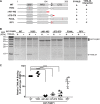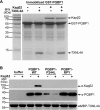The Renpenning syndrome-associated protein PQBP1 facilitates the nuclear import of splicing factor TXNL4A through the karyopherin β2 receptor
- PMID: 32041777
- PMCID: PMC7105315
- DOI: 10.1074/jbc.RA119.012214
The Renpenning syndrome-associated protein PQBP1 facilitates the nuclear import of splicing factor TXNL4A through the karyopherin β2 receptor
Abstract
Renpenning syndrome belongs to a group of X-linked intellectual disability disorders. The Renpenning syndrome-associated protein PQBP1 (polyglutamine-binding protein 1) is intrinsically disordered, associates with several splicing factors, and is involved in pre-mRNA splicing. PQBP1 uses its C-terminal YxxPxxVL motif for binding to the splicing factor TXNL4A (thioredoxin like 4A), but the biological function of this interaction has yet to be elucidated. In this study, using recombinant protein expression, in vitro binding assays, and immunofluorescence microscopy in HeLa cells, we found that a recently reported X-linked intellectual disability-associated missense mutation, resulting in the PQBP1-P244L variant, disrupts the interaction with TXNL4A. We further show that this interaction is critical for the subcellular location of TXNL4A. In combination with other PQBP1 variants lacking a functional nuclear localization signal required for recognition by the nuclear import receptor karyopherin β2, we demonstrate that PQBP1 facilitates the nuclear import of TXNL4A via a piggyback mechanism. These findings expand our understanding of the molecular basis of the PQBP1-TXNL4A interaction and of the etiology and pathogenesis of Renpenning syndrome and related disorders.
Keywords: PQBP1; Renpenning syndrome; TXNL4A; X-linked intellectual disability; autism; neurodevelopment; nuclear transport; protein complex; protein import; protein-protein interaction; splicing factor.
© 2020 Liu et al.
Conflict of interest statement
The authors declare that they have no conflicts of interest with the contents of this article
Figures





Similar articles
-
Molecular consequences of PQBP1 deficiency, involved in the X-linked Renpenning syndrome.Mol Psychiatry. 2024 Feb;29(2):287-296. doi: 10.1038/s41380-023-02323-5. Epub 2023 Nov 29. Mol Psychiatry. 2024. PMID: 38030819
-
The role of PQBP1 in neural development and function.Biochem Soc Trans. 2023 Feb 27;51(1):363-372. doi: 10.1042/BST20220920. Biochem Soc Trans. 2023. PMID: 36815699 Review.
-
A mild clinical and neuropsychological phenotype of Renpenning syndrome: A new case report with a maternally inherited PQBP1 missense mutation.Appl Neuropsychol Child. 2022 Oct-Dec;11(4):921-927. doi: 10.1080/21622965.2021.1970551. Epub 2021 Sep 1. Appl Neuropsychol Child. 2022. PMID: 34470565
-
Renpenning syndrome in a female.Am J Med Genet A. 2020 Mar;182(3):498-503. doi: 10.1002/ajmg.a.61451. Epub 2019 Dec 16. Am J Med Genet A. 2020. PMID: 31840929
-
[Structural study of polyglutamine tract-binding protein 1].Yakugaku Zasshi. 2013;133(5):519-26. doi: 10.1248/yakushi.13-00001-2. Yakugaku Zasshi. 2013. PMID: 23649393 Review. Japanese.
Cited by
-
Role of PQBP1 in Pathogen Recognition-Impact on Innate Immunity.Viruses. 2024 Aug 21;16(8):1340. doi: 10.3390/v16081340. Viruses. 2024. PMID: 39205314 Free PMC article. Review.
-
Splicing Modulators Are Involved in Human Polyglutamine Diversification via Protein Complexes Shuttling between Nucleus and Cytoplasm.Int J Mol Sci. 2023 Jun 1;24(11):9622. doi: 10.3390/ijms24119622. Int J Mol Sci. 2023. PMID: 37298574 Free PMC article.
-
Fatal Attraction: The Case of Toxic Soluble Dimers of Truncated PQBP-1 Mutants in X-Linked Intellectual Disability.Int J Mol Sci. 2021 Feb 24;22(5):2240. doi: 10.3390/ijms22052240. Int J Mol Sci. 2021. PMID: 33668121 Free PMC article. Review.
-
Molecular consequences of PQBP1 deficiency, involved in the X-linked Renpenning syndrome.Mol Psychiatry. 2024 Feb;29(2):287-296. doi: 10.1038/s41380-023-02323-5. Epub 2023 Nov 29. Mol Psychiatry. 2024. PMID: 38030819
-
A rare etiology of tetralogy of Fallot with pulmonary atresia: Renpenning syndrome.Anatol J Cardiol. 2022 Feb;26(2):149-150. doi: 10.5152/AnatolJCardiol.2021.554. Anatol J Cardiol. 2022. PMID: 35190366 Free PMC article. No abstract available.
References
-
- Kalscheuer V. M., Freude K., Musante L., Jensen L. R., Yntema H. G., Gécz J., Sefiani A., Hoffmann K., Moser B., Haas S., Gurok U., Haesler S., Aranda B., Nshedjan A., Tzschach A., et al. (2003) Mutations in the polyglutamine binding protein 1 gene cause X-linked mental retardation. Nat. Genet. 35, 313–315 10.1038/ng1264 - DOI - PubMed
-
- Stevenson R. E., Bennett C. W., Abidi F., Kleefstra T., Porteous M., Simensen R. J., Lubs H. A., Hamel B. C., and Schwartz C. E. (2005) Renpenning syndrome comes into focus. Am. J. Med. Genet. A 134, 415–421 - PubMed
Publication types
MeSH terms
Substances
Supplementary concepts
Associated data
- Actions
LinkOut - more resources
Full Text Sources
Other Literature Sources
Medical
Research Materials

